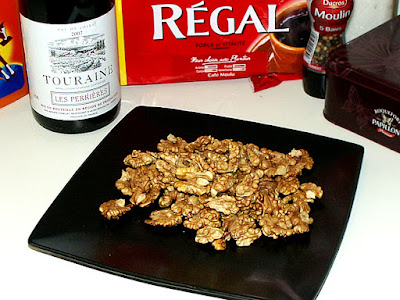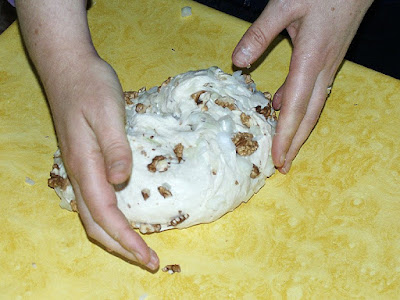
The Virginia Creeper covered house on the right is 1 Place des Halles and has an extremely interesting history; in 1920 it was the co-operative bakery. As far as we can work out, these were set up in each town as required by law to ensure that bread was fairly distributed to all in France, where extremely hard times followed the devastation caused by the First World War. The building on the left is Dr Martin's
veterinary surgery, which I have already written about.
According to Roger Lezeau:
It was here that one found the co-operative bakery created out of necessity during the war. Monsieur and Madame Ridet and their daughter Berthe ensured that there was bread for sale but did not engage in its manufacture. Monsieur Nibodeau succeeded them.
At this time the baguette*, as in Paris, made its first appearance in Preuilly.
Sourdough (miche) was sold whole although other breads could be cut, enabling the baker to add a small slice to an order to make up the weight** [according to Roger, known as the amandon, or 'kernel', but I wonder if this is a play on words, because donner la miche = faire l'aumône = to give alms, and the baker may have been more or less generous with people.]
Ranges and ovens were not yet in use in town houses, and you could take tarts, stuffed tomatoes, roast veal, and even a dish made from haricots blancs called les pouais [which I fear may be an onomatopaic word] to the bakeries to cook. The flavours were greatly enhanced in the oven, delighting the nostrils of the kids charged with fetching the oven baked dish.
But to return to our co-op (copé) – you paid for the bread there with ration cards, the value of which varied depending on their colour. Although rationing did not cease immediately after the war, the quality of the bread improved rapidly.
The shop has been gone for decades and the building is now private homes.
Roger Lezeau's anecdote translated by me from his article in Les Cahiers de la Poterne, No34. Monsieur Lezeau was born in 1912 and is a great source of knowledge about the history of Preuilly.
Food shortages did not begin to affect [the more] southern
unoccupied part of France (where we are) until 1916, but in May of that year, the so-called 'national bread' was introduced. It became less and less palatable throughout the duration of the war and by November 1916 it was rationed. The harvest of 1916 had been generally poor and the winter of 1916-17 harsh. Women workers in Paris led food riots, forcing the government to introduce rationing. Rationed foods in the north were paid for using a specially issued paper currency known as
bons (which I think must have been issued by the Germans. I think the ration coupons used later and in the south were different, but also known as
bons). [Our regular French reader, CHM, tells me that the
bons were the same throughout and administered by the French government on French soil. I think my confusion arose because it can be difficult separating the situation in Belgium and in France at this time with the surprisingly sparse references available on the internet.]
The 'national bread' was made from no more than one third wheat flour, with another third rye and the balance made up of maize and rice. It had an extremely hard crust, and most people considered it almost inedible. Many bakeries closed due to the lack of supplies.
In the north, the food shortages started much earlier in the war, and were far worse. The
occupying German army removed to Germany what crops had survived the fighting in 1914. By 1915 the bread ration in Lille was 200g per adult per day and 100g per child. There were rumours that the ration would go down to 140g per day for adults and 40g for children, and it did eventually fall to that level.
An extraordinary international food aid programme was masterminded by Herbert Hoover (then a millionaire businessman, later President of the United States), and co-ordinated by diplomats from Britain, the United States, Spain and the Netherlands. They could get food to France and Belgium relatively easily by sea or through neighbouring neutral countries, but once in the
occupied war zone, distribution did sometimes become problematic. The negotiations with the German command were continual.
After the war, France found itself responsible for many refugees and immigrant labourers who had been brought in to help keep the country functioning on the domestic front, and chose to stay permanently.
I assume that our property was a
graineterie (grain merchant's) at this time, and I would love to find some information on our place at this time and how the proprietors coped with the situation.
Susan
*For more on the history of the baguette see Simon's post
In Praise of Bread.
**There are still regulations that mean that some types of bread must be sold by weight, others can be sold by the loaf.
 In the above photo you can see various local delicacies including crumbed pigs trotters (pig feet for you Southerners), Farci Poitevin (a whole cabbage stuffed with pork and sorrel pâte and simmered for hours in court bouillion), assorted pâtes and rillettes. The round pan beyond the trotters is a civet de sanglier. A civet is a game stew (in this case wild boar) traditionally made by hunters in the field, using the blood of the animal to thicken the sauce. These days they are mostly made with red wine and perhaps some minced chicken liver to give a taste and mouthfeel reminiscent of the traditional recipe. The same stall also sells boudin blanc and boudin noir in both natural and truffle laced states. (Taste bud alert!)
In the above photo you can see various local delicacies including crumbed pigs trotters (pig feet for you Southerners), Farci Poitevin (a whole cabbage stuffed with pork and sorrel pâte and simmered for hours in court bouillion), assorted pâtes and rillettes. The round pan beyond the trotters is a civet de sanglier. A civet is a game stew (in this case wild boar) traditionally made by hunters in the field, using the blood of the animal to thicken the sauce. These days they are mostly made with red wine and perhaps some minced chicken liver to give a taste and mouthfeel reminiscent of the traditional recipe. The same stall also sells boudin blanc and boudin noir in both natural and truffle laced states. (Taste bud alert!) There is also ham and other cured cuts of pork including bellies, which sliced thinly could make really interesting streaky bacon (I have my taste buds really excited now...) Alongside them are sold any number of varieties of saucisson sec (think French salami) including wild boar, deer, and smoked duck. We took a photo of these last year.
There is also ham and other cured cuts of pork including bellies, which sliced thinly could make really interesting streaky bacon (I have my taste buds really excited now...) Alongside them are sold any number of varieties of saucisson sec (think French salami) including wild boar, deer, and smoked duck. We took a photo of these last year. Just as truffles are not the only fruit, nor is pork the only meat. We were surprised by how much biche (venison – specifically hind ie female Red Deer) there was on sale. I am not sure how you cook a whole front leg of deer - I assume you roast it in a big oven or maybe on a spit over charcoal. (Taste buds have been set off again)
Just as truffles are not the only fruit, nor is pork the only meat. We were surprised by how much biche (venison – specifically hind ie female Red Deer) there was on sale. I am not sure how you cook a whole front leg of deer - I assume you roast it in a big oven or maybe on a spit over charcoal. (Taste buds have been set off again) If you're not into meat there is usually a range of breads, dried fruits and jams. And, of course, truffles. The attractive photo below is of brioche and Tourteau Fromagé (literally a cheese crab), a kind of brioche made with goats cheese and cooked really hot at first so the top "burns". Clotilde has written about it on Chocolate & Zucchini. I really like it - Susan isn't convinced. Like the Farci Poitevin, it too is a very local regional dish.
If you're not into meat there is usually a range of breads, dried fruits and jams. And, of course, truffles. The attractive photo below is of brioche and Tourteau Fromagé (literally a cheese crab), a kind of brioche made with goats cheese and cooked really hot at first so the top "burns". Clotilde has written about it on Chocolate & Zucchini. I really like it - Susan isn't convinced. Like the Farci Poitevin, it too is a very local regional dish. There is also usually a stall selling snails. I can't work out if snails are meat or not, so I won't mention them. Taste buds are now back to normal, by the way.
There is also usually a stall selling snails. I can't work out if snails are meat or not, so I won't mention them. Taste buds are now back to normal, by the way.













































